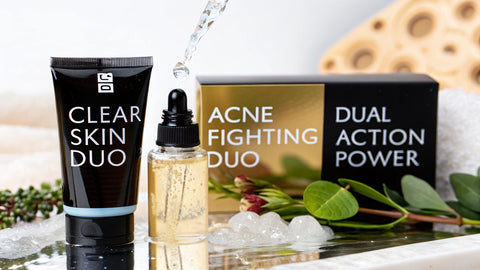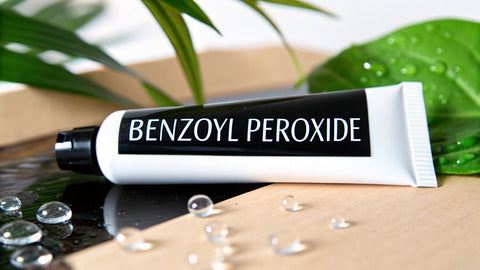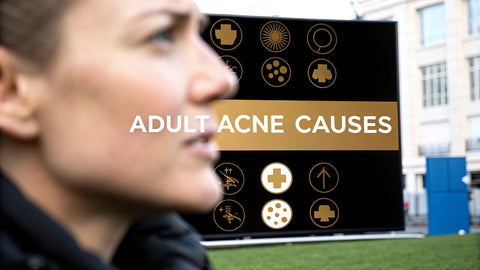How to Build a Skincare Routine for Clear Skin
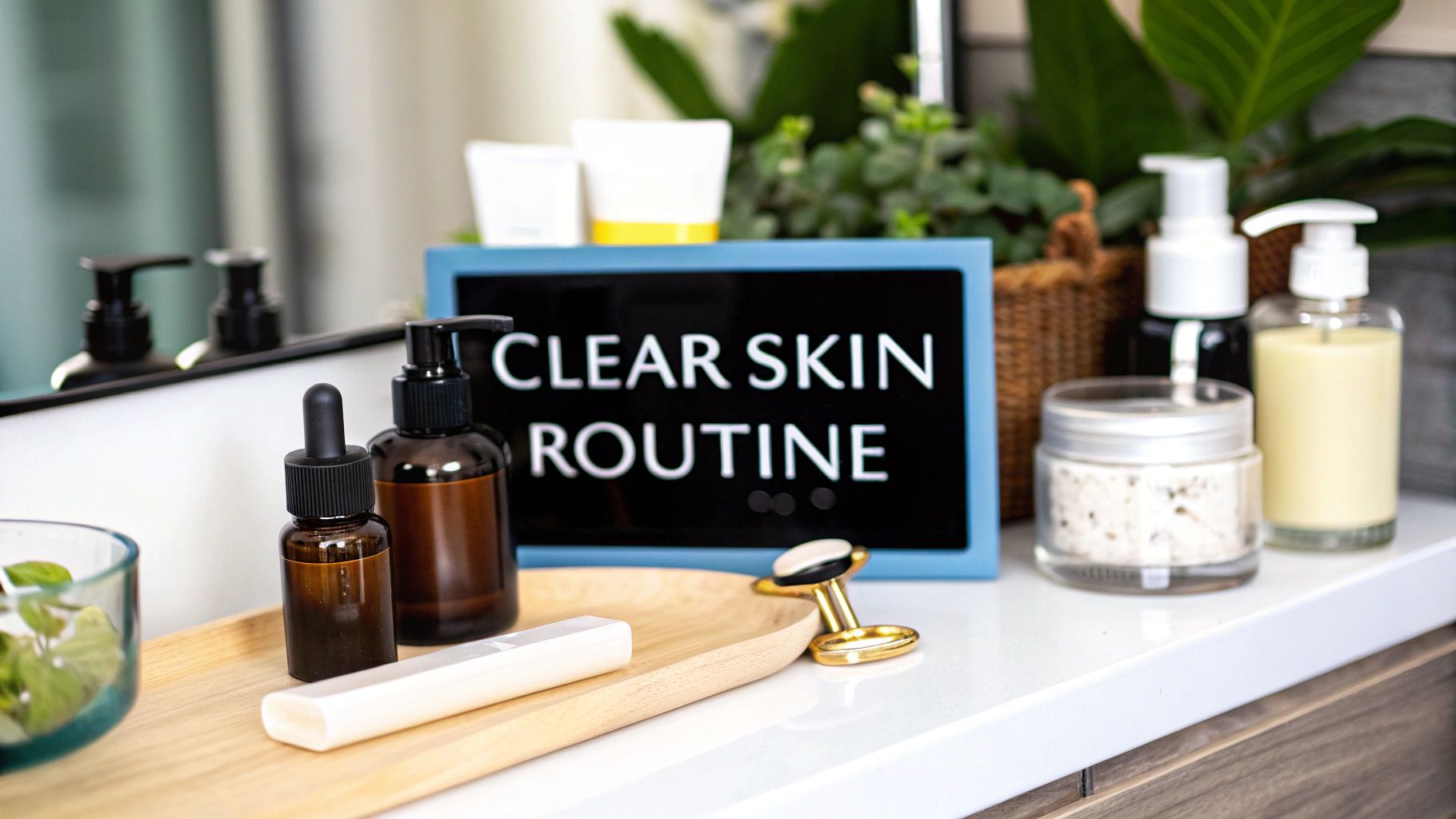
Getting your skincare routine right is a personal journey, but every successful path is built on three universal pillars: cleansing, moisturizing, and sun protection. Nailing these foundational steps creates the perfect canvas for adding targeted acne treatments later on. It's truly the most reliable way to achieve consistently clear, calm skin.
Establishing Your Core Skincare Foundation
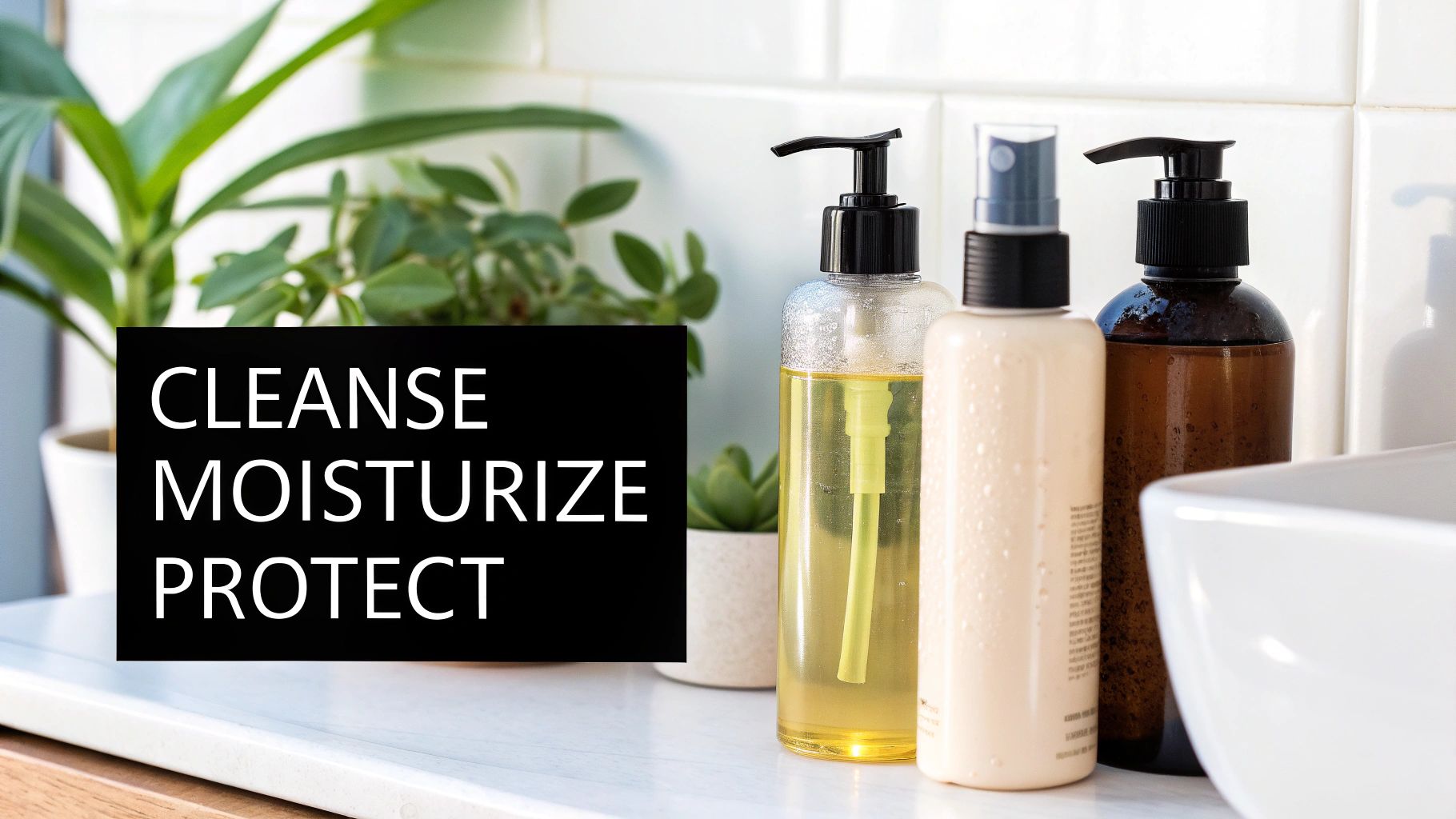
Before you even think about potent serums and spot treatments, we have to get the non-negotiables right. Think of these core steps as the bedrock of your entire routine. Without a solid foundation, even the most advanced acne-fighting ingredients can fall flat or, even worse, cause more irritation.
A simple, consistent routine gives your skin a chance to stabilize and heal. By focusing only on the essentials at first, you're supporting your skin's natural barrier function. This protective shield is absolutely crucial for keeping moisture in and irritants out—something every person dealing with acne needs.
The Power of a Proper Cleanse
Washing your face seems so simple, but it’s the step where many routines go wrong. The goal isn't to scrub your skin squeaky clean; it's to gently remove impurities like excess oil, dirt, and makeup without stripping the skin of its essential moisture.
Over-washing or using harsh, high-pH cleansers can actually damage your skin barrier. When that happens, your skin can freak out, leading to increased oil production and more breakouts. It’s the exact opposite of what you're trying to achieve.
Recent data shows a surprising gap in how people wash their faces. While 52% of consumers use dedicated cleansing products, a huge portion—over one-third—still just use water. That simply isn't enough to remove the daily buildup of oil, pollutants, and sunscreen that can clog pores and feed acne.
To really kickstart your journey, consider getting one or two professional facial treatments to deeply cleanse and reset your skin. This gives you a strong, clean foundation for your daily habits to build upon.
Debunking the Moisturizer Myth
One of the most stubborn skincare myths out there is that oily or acne-prone skin doesn't need a moisturizer. Nothing could be further from the truth. When you skip hydration, your skin gets dehydrated and tries to compensate by producing even more oil, which just leads to more clogged pores.
The secret is choosing the right kind of moisturizer. Look for formulas with these features:
- Non-comedogenic: This is a must-have term. It means the product is specifically formulated not to clog pores.
- Lightweight: Gel or lotion textures feel much better on oily skin than heavy, rich creams.
- Barrier-supporting: Keep an eye out for ingredients like niacinamide and ceramides, which help strengthen your skin's protective barrier.
A well-formulated moisturizer doesn't add grease; it adds balance. For acne-prone skin, a balanced complexion is a calmer, clearer complexion.
For a quick-reference guide, here's a simple blueprint for getting your daily essentials in order.
Your Daily Skincare Blueprint for Acne Prone Skin
| Step | Morning (AM) Focus | Evening (PM) Focus | Primary Goal |
|---|---|---|---|
| 1. Cleanse | Gentle Foaming/Gel Cleanser | Gentle Foaming/Gel Cleanser | Remove impurities without stripping skin's natural oils. |
| 2. Moisturize | Lightweight, Oil-Free Moisturizer | Non-Comedogenic Moisturizer | Hydrate and support the skin barrier to prevent excess oil production. |
| 3. Protect | Broad-Spectrum SPF 30+ | (Not applicable) | Prevent sun damage and stop post-acne marks from darkening. |
This table lays out the absolute essentials. Once you have this down consistently, you can start thinking about adding treatments.
Sunscreen: Your Ultimate Acne Aftercare
Finally, let's talk about the single most critical step for anyone serious about managing acne and its aftermath: sunscreen. Sun exposure can darken those red or brown marks (post-inflammatory hyperpigmentation) left behind by pimples, making them stick around for months or even years.
Applying a broad-spectrum sunscreen with at least SPF 30 every single morning is your best defense. Not only does it protect you from skin cancer and premature aging, but it also helps your post-acne marks fade much faster, leading to a more even-toned complexion. Think of it as protecting all the hard work you're putting in with your other products.
Choosing Your Acne-Fighting Ingredients
Once you have a solid, basic routine down—cleanser, moisturizer, SPF—it's time to bring in the heavy hitters. This is where you start to really customize your approach and go on the offensive against breakouts.
Think of it as moving beyond just maintaining your skin to actively treating it. To do that effectively, you need to understand what you're putting on your face and why. The global skincare market is booming, expected to hit over $200 billion by 2030, which means there are more products on the shelves than ever. Knowing your ingredients is the key to cutting through the noise and finding what actually works for you. You can read more about this massive industry growth and what it means for consumers on meiyume.com.
Salicylic Acid: The Pore-Clearing Powerhouse
If you’re battling blackheads, whiteheads, or just general clogged pores, Salicylic Acid is your best friend. It’s a Beta Hydroxy Acid (BHA), and its claim to fame is that it's oil-soluble.
So, what does that actually mean? It means it can get deep down inside your pores, where the trouble starts, and dissolve the gunk (a lovely mix of dead skin and oil) that causes clogs in the first place. It's like a deep clean from the inside out.
At Neutralyze, we harness the power of Salicylic Acid in our formulas to provide a first line of defense against congestion. By tackling the problem at the source, it not only clears existing breakouts but also prevents new ones from forming, making it a cornerstone ingredient for maintaining clear skin.
Mandelic Acid: The Gentle Resurfacer
Not all skin can handle intense ingredients. If your skin is on the sensitive side, or if you're stuck with those frustrating dark spots that linger long after a pimple is gone, Mandelic Acid is an incredible option.
As an Alpha Hydroxy Acid (AHA), Mandelic Acid has larger molecules than its more famous cousin, Glycolic Acid. This might sound technical, but all it really means is that it sinks into your skin more slowly and gently, so you get the exfoliating benefits without the irritation.
Mandelic Acid pulls double duty. It smooths your skin's surface for a brighter look and helps fade the post-acne marks (that's post-inflammatory hyperpigmentation) for a more even skin tone.
Neutralyze has made Mandelic Acid a hero ingredient precisely for this reason. It offers a gentle yet highly effective solution for improving skin texture and tone, making it the perfect choice when you need visible results without risking the redness and peeling that can come with stronger acids.
Sulfur: The Anti-Inflammatory Specialist
Sulfur might sound a bit old-fashioned, but don't underestimate it. There's a reason dermatologists have recommended it for decades: it excels at calming down those red, angry, inflamed pimples.
Sulfur gets the job done in two main ways:
- It has antibacterial properties that help keep acne-causing bacteria in check.
- It acts as a keratolytic, which means it helps dry out the surface of a blemish and encourages the shedding of dead skin cells to unclog the pore.
You'll often find Sulfur in spot treatments and masks because it works quickly to take down the size and redness of a nasty pimple. This is why we include it in our targeted formulas—to provide you with a fantastic tool for fast-acting, on-the-spot relief.
Choosing the right active ingredient really comes down to knowing your skin's specific needs. Are you dealing with deep clogs, surface texture, or angry inflammation? The table below breaks down these powerhouse ingredients to help you decide.
Key Acne Ingredients and Their Functions
| Ingredient | What It Does | Best For | Found In Neutralyze |
|---|---|---|---|
| Salicylic Acid | A BHA that penetrates pores to dissolve oil & dead skin. | Clogged pores, blackheads, whiteheads, oily skin. | Neutralyze Face Wash, Spot Treatment |
| Mandelic Acid | A gentle AHA that exfoliates the skin's surface. | Sensitive skin, dark spots (hyperpigmentation), uneven texture. | Neutralyze Clearing Serum, Face Wash |
| Sulfur | An anti-inflammatory agent that dries out pimples and kills bacteria. | Red, inflamed pimples (pustules), inflammatory acne. | Neutralyze Spot Treatment |
Ultimately, understanding what Salicylic Acid, Mandelic Acid, and Sulfur do is your first step toward building a truly effective routine. Neutralyze built its entire line around these science-backed ingredients for this very reason. To learn even more, check out our complete guide on the best ingredients for acne-prone skin. This knowledge puts you firmly in the driver's seat on your journey to clear skin.
The Art of Layering Your Skincare Products
So, you've got the right products. That's a huge win. But if you’re applying them in the wrong order, you might as well be throwing them away. The sequence you layer your skincare is everything—it determines how well each product absorbs and, ultimately, how effective it is.
It really is the difference between a routine that delivers results and one that just… sits on your skin.
The golden rule here is surprisingly simple: apply your products from the thinnest consistency to the thickest. It's just like getting dressed in the winter; you wouldn't pull your t-shirt on over a bulky parka. Lighter, water-based products need to go on first so they can actually penetrate the skin. Thicker, creamier products are applied last to seal it all in.
This simple logic means that your powerful, targeted treatments—like the active ingredients in your Neutralyze Clearing Serum—get a direct line to your skin. They don't have to battle through a heavy layer of moisturizer to do their job. Honestly, mastering this one small change can dramatically improve your results.
Your Morning Layering Blueprint: All About Protection
Your morning routine has one primary mission: defense. You want to gently cleanse, treat, and hydrate your skin, and then—most importantly—shield it from everything the day throws at you, especially the sun.
Here’s a practical sequence to follow in the A.M.:
- Cleanser: Start by washing with a gentle cleanser. This gets rid of any oil and gunk that built up overnight and gives you a clean canvas to work with.
- Toner (Optional): If you use a toner, now’s the time. A quick swipe on a dry face can help rebalance your skin’s pH and prep it for what comes next.
- Treatment Serum: This is the moment for a powerhouse product like the Neutralyze Clearing Serum. A thin layer is all you need to let its Mandelic Acid get to work.
- Moisturizer: Follow that up with a lightweight, non-comedogenic moisturizer to hydrate and keep your skin barrier happy.
- Sunscreen: Don't even think about skipping this. A broad-spectrum SPF of 30 or higher is non-negotiable for protecting your skin from UV damage, which can make those post-acne marks stick around for much longer.
Your Evening Layering Blueprint: Time for Treatment and Repair
Nighttime is when the magic happens. While you're sleeping, your skin goes into full-on recovery mode, making it the perfect opportunity to hit it with your most effective acne-fighting treatments.
This infographic gives a great overview of how the key ingredients in your routine work together.
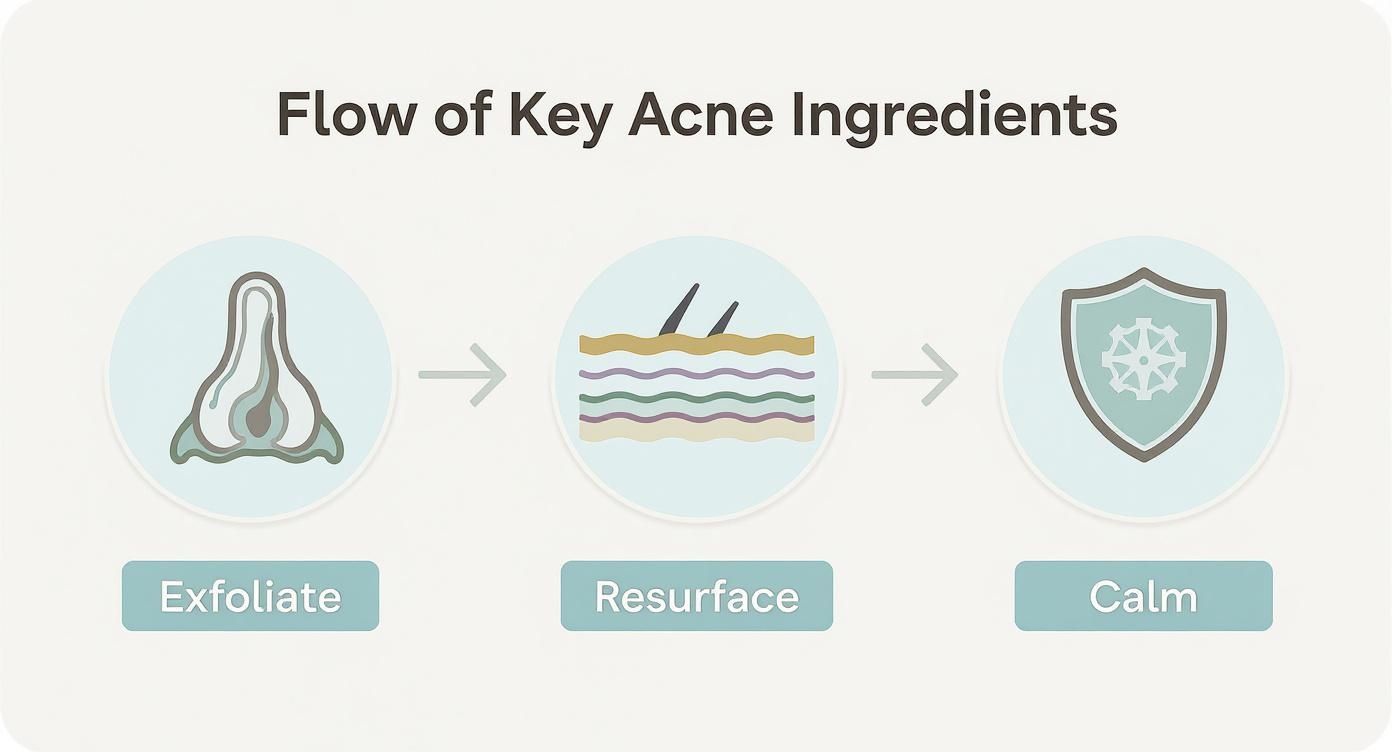
As you can see, it’s a multi-pronged attack: first exfoliating deep inside the pores, then resurfacing the skin, and finally, calming down all that angry inflammation.
Here’s how to layer your products for maximum impact at night:
- Cleanser: Wash your face thoroughly. You need to get every last trace of makeup, sunscreen, oil, and city grime off before you do anything else.
- Toner (Optional): Same as in the morning, a quick splash of toner can be a good next step.
- Treatment Serum: Apply your serum again to keep targeting breakouts and improving skin texture while you sleep.
- Spot Treatment: Now, grab your Neutralyze Spot Treatment and apply it directly onto any active pimples. This is where people get confused—should it go on before or after moisturizer?
Pro Tip: Always apply spot treatments before your moisturizer. This allows the active ingredients, like Sulfur and Salicylic Acid, to penetrate the blemish directly without being diluted or blocked by a thick cream.
- Moisturizer: Finish up with your moisturizer. This final step locks in all those potent treatments and keeps your skin hydrated overnight.
One last piece of advice I always give people: try to give each layer a minute or two to sink in. You don't need a stopwatch, but just letting each product absorb a bit before moving on can prevent that annoying pilling and ensures everything works as it should. Follow this simple layering strategy, and you're giving your products the best possible chance to get you closer to your clear skin goals.
Customizing Your Routine for Your Skin Type
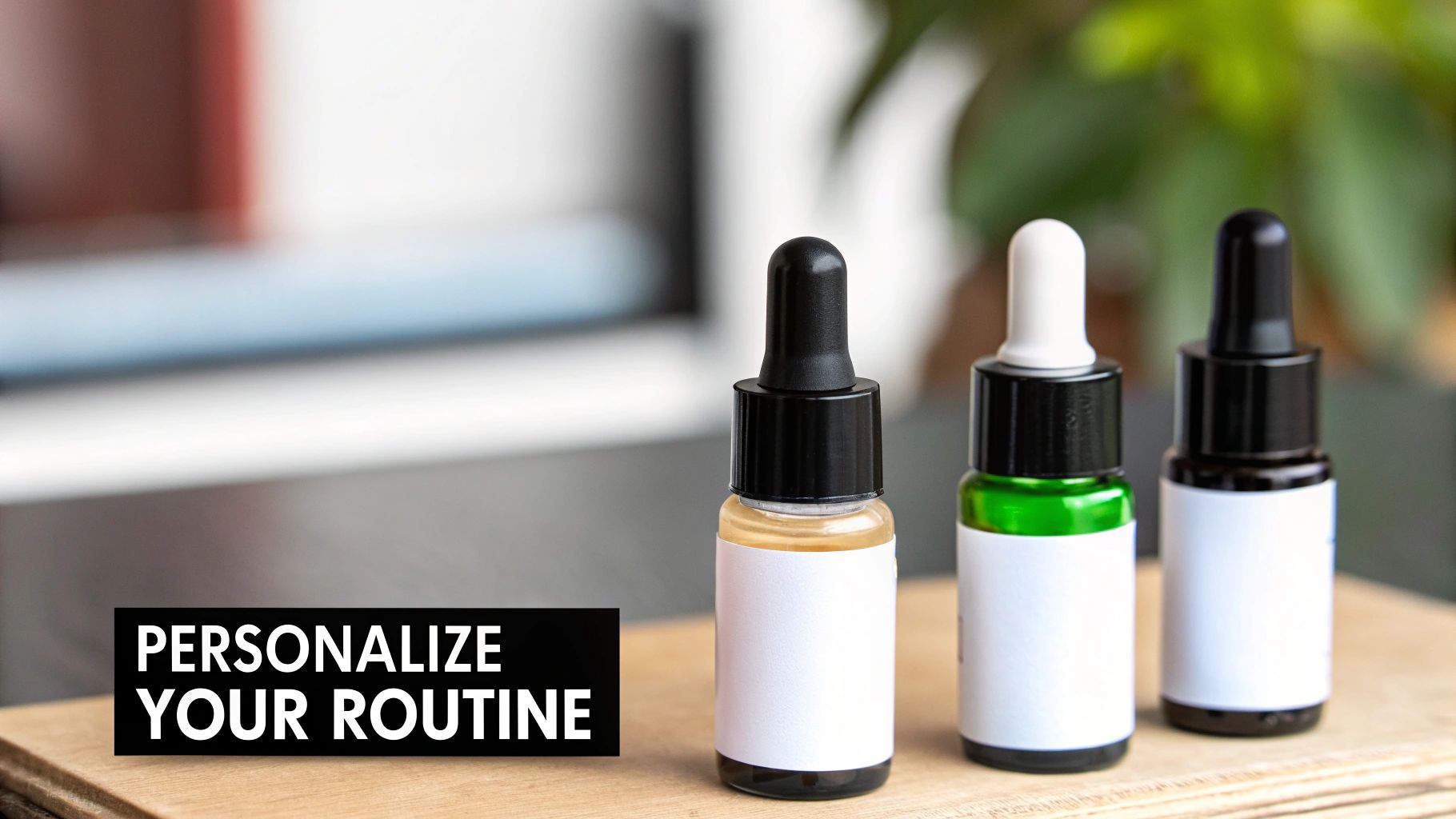
If layering products is the science of building a great skincare routine, understanding your skin type is the art. A one-size-fits-all approach to acne is practically guaranteed to fail. Why? Because the same ingredient can be a lifesaver for oily skin but a complete disaster for dry skin.
Honestly, getting to know your skin's unique quirks is the most important step you'll take. It’s what turns a random collection of products into a routine that actually delivers lasting clarity.
This is where true personalization comes in. The skincare market, valued at over $115 billion, has finally caught on, shifting away from generic "acne washes" to formulas that address specific concerns. Consumers are smarter now and demand routines that fit their needs. When you see professionals using detailed esthetician client consultation forms, it's all about gathering this crucial info. You can start that same process at home by simply paying attention.
Tailoring Your Approach to Oily Skin
Does your face feel greasy by lunch? Are you constantly reaching for blotting papers to combat shine? If so, you've probably got an oily skin type. Your sebaceous glands are just a bit overzealous, which can quickly lead to clogged pores and breakouts.
The single biggest mistake people with oily skin make is trying to strip it dry with harsh, aggressive products. It feels like the right thing to do, but it just backfires. Your skin panics, your barrier gets damaged, and it produces even more oil to compensate.
Instead, the goal is balance.
- Find the Right Moisturizer: Don't skip it! Look for lightweight, oil-free moisturizers, usually in a gel or gel-cream formula. They give you the hydration your skin needs without feeling heavy or greasy.
- Make Salicylic Acid Your Best Friend: This BHA is a game-changer for oily skin. It’s oil-soluble, which means it can dive deep into your pores to dissolve all that gunk and keep them clear from the inside out.
Calming and Hydrating Dry, Acne-Prone Skin
Having skin that's both dry and acne-prone can feel like a cruel joke, but it's incredibly common. Your skin lacks the oils it needs to stay moisturized, which often leads to a tight, flaky feeling and a compromised skin barrier. A weak barrier is like an open door for bacteria and inflammation—a perfect recipe for breakouts.
Your entire focus should be on hydrating and strengthening that barrier without clogging your pores. It’s a delicate balance.
For dry, acne-prone skin, the mission is simple: add hydration without adding congestion. Gentle exfoliation followed by barrier-supporting ingredients is the key to breaking the cycle of dryness and breakouts.
Look for non-comedogenic moisturizers that are richer than a gel but not so heavy they feel suffocating. When it comes to exfoliants, an ingredient like Mandelic Acid is ideal. It’s a larger molecule, so it works on the surface to gently slough off dead skin cells without the irritation you might get from other, more intense acids.
Managing Combination Skin
Welcome to the club where you're dealing with two different skin types at once. For most people with combination skin, this means an oily T-zone (forehead, nose, and chin) with dry or normal cheeks. This setup demands a bit more strategy.
The solution is often targeted application. Think of it as giving each part of your face what it actually needs.
For example, you could use a clay-based mask with Sulfur on your T-zone to soak up excess oil, while applying a creamy, hydrating mask to your cheeks at the same time. You can do the same with your treatments—concentrate your Salicylic Acid on the oily areas and use a gentler hydrator everywhere else.
Nurturing Sensitive, Reactive Skin
If your skin turns red, stings, or gets itchy at the mere thought of a new product, you’re on team sensitive. Your skin barrier is highly reactive, so introducing powerful acne-fighting ingredients requires patience and a gentle hand.
The absolute golden rule here is to patch test. Before you slather a new product all over your face, apply a tiny amount to a hidden spot, like behind your ear or on your inner arm. Wait 24-48 hours to see if there’s any reaction.
When you're ready to start a potent formula like Neutralyze, go slow. Begin by using it just two or three times a week. If your skin is happy, you can gradually increase the frequency. This slow-and-steady approach lets your skin build tolerance, so you get all the blemish-fighting benefits without the irritation.
Troubleshooting Common Skincare Problems
Building the right skincare routine is a process of trial and error—it's never a one-and-done deal. It’s completely normal to hit a few bumps along the way, even when you're using fantastic products. Your skin can throw you a curveball, and that's okay.
The key is learning to read your skin's signals and make smart adjustments. Think of this as your field guide for navigating the real-world challenges of treating acne, so you can stay on track to your clear-skin goals.
Is It Purging or a Real Breakout?
This is probably the most confusing hurdle you'll face. You start a new acne treatment, excited for results, and suddenly your skin gets worse. The immediate impulse is to panic and toss the product, but hold on—this might actually be a good sign.
It’s likely skin purging. This happens when active ingredients like Salicylic or Mandelic Acid hit the accelerator on your skin cell turnover. All that gunk that was already brewing under the surface—clogged pores and tiny pre-pimples—gets pushed to the top all at once. It’s a frustrating "it gets worse before it gets better" situation, but it means the product is doing its job.
So, how can you tell the difference?
- Look at the Location: Purging almost always happens in your usual trouble spots. If you're suddenly getting blemishes in brand-new areas where you’re normally clear, it might be a negative reaction instead.
- Check the Speed: Pimples from a purge tend to have a shorter life cycle. They pop up and heal much faster than those stubborn, deep-set breakouts you're used to.
- Watch the Clock: A true purge should only last about four to six weeks, which is roughly one full skin renewal cycle. If the new breakouts continue beyond that, it might be time to admit the product isn't the right fit.
Purging is a temporary detour on the road to clearer skin. It’s a sign that the active ingredients are working deep down. My best advice? Be patient and stay consistent.
Dealing with Dryness and Irritation
Introducing powerful acne-fighting ingredients can sometimes leave your skin feeling tight, dry, or flaky. This is a common signal that your skin is still adjusting or that your moisture barrier is crying out for a little extra support. Don’t worry, it's totally manageable.
If you start feeling irritated, the first thing to do is simplify. Strip your routine back to the bare essentials: a gentle cleanser and a solid, barrier-supporting moisturizer. Give your skin a few days to calm down before slowly reintroducing your treatment.
Here are a few tricks I recommend:
- Scale Back: Instead of using your Neutralyze Clearing Serum every single night, try switching to every other night, or even just three times a week. This gives your skin time to acclimate without getting overwhelmed.
- Try the "Buffering" Technique: Apply a thin layer of moisturizer before your active treatment. This creates a gentle buffer that can dial down the intensity of the active ingredient without rendering it useless.
- Double Down on Hydration: Make sure your moisturizer contains barrier-loving ingredients like ceramides or niacinamide. A happy, well-hydrated skin barrier is far more resilient and less likely to get irritated in the first place.
What to Do When a Product Just Stops Working
Ever have a holy grail product that works magic for months, and then one day... nothing? It feels like your skin has suddenly become "immune" to it. This skincare plateau is real, but it’s rarely about the product itself. More often, the conditions around it have changed.
Take a step back and think about what else is going on. A change in seasons is a huge factor. That lightweight gel moisturizer that felt perfect in the humid summer months probably isn't cutting it in the dry winter air. This can compromise your skin barrier, making it seem like your acne treatment has failed.
Lifestyle shifts like a spike in stress or a change in diet can also throw your skin for a loop. Before you break up with a product that once worked wonders, do a little detective work. It might not be the product that needs to change, but the supporting players in your routine or your life.
Your Skincare Routine Questions, Answered
Starting a new skincare routine for acne can feel overwhelming, and it's totally normal for questions to come up along the way. Even the most seasoned skincare enthusiasts have been there. Let’s clear up some of the most common uncertainties you might face as you start your journey to clearer skin.
How Long Until I See Results From a New Acne Routine?
This is the big one, isn't it? We all want results yesterday. In reality, you'll need to give your new routine at least 4-6 weeks to see a meaningful change. Why so long? It's all about your skin's natural cell turnover cycle, which takes about 28 days for new cells to reach the surface.
Active ingredients, like the Mandelic and Salicylic Acid you'll find in Neutralyze products, need that full cycle to really get in there, clear out clogged pores, and start preventing new breakouts. Some people even go through a "purging" phase for the first 2-4 weeks where things seem to get a little worse before they get better. The absolute key here is sticking with it. Consistency is everything.
Can I Mix and Match Products From Different Brands?
You can, but you have to be smart about it. Think of yourself as a chemist for your own face. The most important thing is to watch your active ingredients like a hawk. Doubling up on powerful exfoliants—think combining AHAs, BHAs, and a retinoid all at once—is a fast track to irritation and a compromised skin barrier.
Our best advice? Start with a complete system where the products are designed to work together, like the Neutralyze kits. Our formulas are expertly balanced to deliver maximum efficacy without irritation, taking the guesswork out of it for you. This gives your skin a stable, effective foundation. Once your skin has adjusted and feels balanced, you can start experimenting by introducing one new product at a time from another brand.
Why Do I Need a Separate Morning and Night Routine?
Your morning and evening routines have completely different jobs. I like to think of it as playing defense during the day and offense at night.
- Morning Routine (Defense): Your AM routine is all about protection. The goal is to guard your skin against everything the day throws at it, especially UV rays and pollution. The absolute must-haves are a gentle cleanser, a light moisturizer, and of course, a broad-spectrum sunscreen.
- Evening Routine (Offense): Nighttime is for treatment and repair. After you've washed the day off, it’s the perfect time to apply your targeted acne treatments. Active ingredients can work their magic without interruption while your skin is naturally regenerating overnight. This is why a system like Neutralyze is designed with AM and PM use in mind, ensuring your skin gets what it needs 24/7.
What Should I Do if My Skin Gets Red or Irritated?
Listen to your skin! Redness, stinging, peeling, or that uncomfortably tight feeling are your skin’s way of screaming for help. It means you've pushed it too far.
The second you notice signs of irritation, hit the brakes. Strip your routine back to the bare essentials: a gentle cleanser and a simple, soothing moisturizer. Ditch all your active ingredients for a few days until your skin feels calm and happy again.
If you want to give that product another shot, reintroduce it very slowly—maybe just once every three days. This gives your skin a chance to acclimate. If the irritation comes right back, that's your definitive answer. The product just isn't right for you, and it's time to let it go.
Ready to stop guessing and start seeing results? Neutralyze products are built to work in perfect harmony, using a potent blend of Mandelic and Salicylic Acid to fight acne without the drama.
Find your complete acne-fighting solution at Neutralyze.com.
